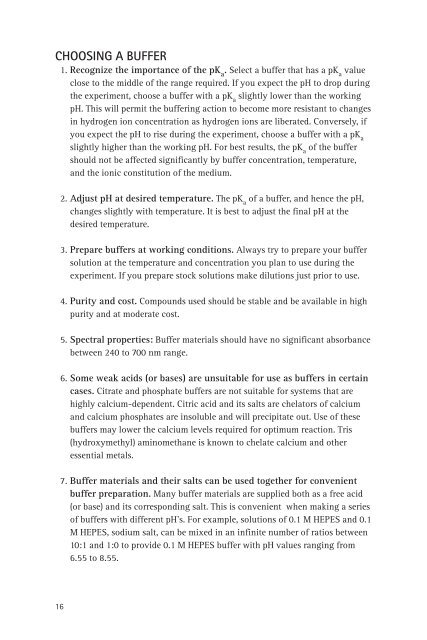A guide for the preparation and use of buffers in biological systems
A guide for the preparation and use of buffers in biological systems
A guide for the preparation and use of buffers in biological systems
Create successful ePaper yourself
Turn your PDF publications into a flip-book with our unique Google optimized e-Paper software.
CHOOSING A BUFFER<br />
1. Recognize <strong>the</strong> importance <strong>of</strong> <strong>the</strong> pK a<br />
. Select a buffer that has a pK a<br />
value<br />
close to <strong>the</strong> middle <strong>of</strong> <strong>the</strong> range required. If you expect <strong>the</strong> pH to drop dur<strong>in</strong>g<br />
<strong>the</strong> experiment, choose a buffer with a pK a<br />
slightly lower than <strong>the</strong> work<strong>in</strong>g<br />
pH. This will permit <strong>the</strong> buffer<strong>in</strong>g action to become more resistant to changes<br />
<strong>in</strong> hydrogen ion concentration as hydrogen ions are liberated. Conversely, if<br />
you expect <strong>the</strong> pH to rise dur<strong>in</strong>g <strong>the</strong> experiment, choose a buffer with a pK a<br />
slightly higher than <strong>the</strong> work<strong>in</strong>g pH. For best results, <strong>the</strong> pK a<br />
<strong>of</strong> <strong>the</strong> buffer<br />
should not be affected significantly by buffer concentration, temperature,<br />
<strong>and</strong> <strong>the</strong> ionic constitution <strong>of</strong> <strong>the</strong> medium.<br />
2. Adjust pH at desired temperature. The pK a<br />
<strong>of</strong> a buffer, <strong>and</strong> hence <strong>the</strong> pH,<br />
changes slightly with temperature. It is best to adjust <strong>the</strong> f<strong>in</strong>al pH at <strong>the</strong><br />
desired temperature.<br />
3. Prepare <strong>buffers</strong> at work<strong>in</strong>g conditions. Always try to prepare your buffer<br />
solution at <strong>the</strong> temperature <strong>and</strong> concentration you plan to <strong>use</strong> dur<strong>in</strong>g <strong>the</strong><br />
experiment. If you prepare stock solutions make dilutions just prior to <strong>use</strong>.<br />
4. Purity <strong>and</strong> cost. Compounds <strong>use</strong>d should be stable <strong>and</strong> be available <strong>in</strong> high<br />
purity <strong>and</strong> at moderate cost.<br />
5. Spectral properties: Buffer materials should have no significant absorbance<br />
between 240 to 700 nm range.<br />
6. Some weak acids (or bases) are unsuitable <strong>for</strong> <strong>use</strong> as <strong>buffers</strong> <strong>in</strong> certa<strong>in</strong><br />
cases. Citrate <strong>and</strong> phosphate <strong>buffers</strong> are not suitable <strong>for</strong> <strong>systems</strong> that are<br />
highly calcium-dependent. Citric acid <strong>and</strong> its salts are chelators <strong>of</strong> calcium<br />
<strong>and</strong> calcium phosphates are <strong>in</strong>soluble <strong>and</strong> will precipitate out. Use <strong>of</strong> <strong>the</strong>se<br />
<strong>buffers</strong> may lower <strong>the</strong> calcium levels required <strong>for</strong> optimum reaction. Tris<br />
(hydroxymethyl) am<strong>in</strong>omethane is known to chelate calcium <strong>and</strong> o<strong>the</strong>r<br />
essential metals.<br />
7. Buffer materials <strong>and</strong> <strong>the</strong>ir salts can be <strong>use</strong>d toge<strong>the</strong>r <strong>for</strong> convenient<br />
buffer <strong>preparation</strong>. Many buffer materials are supplied both as a free acid<br />
(or base) <strong>and</strong> its correspond<strong>in</strong>g salt. This is convenient when mak<strong>in</strong>g a series<br />
<strong>of</strong> <strong>buffers</strong> with different pH’s. For example, solutions <strong>of</strong> 0.1 M HEPES <strong>and</strong> 0.1<br />
M HEPES, sodium salt, can be mixed <strong>in</strong> an <strong>in</strong>f<strong>in</strong>ite number <strong>of</strong> ratios between<br />
10:1 <strong>and</strong> 1:0 to provide 0.1 M HEPES buffer with pH values rang<strong>in</strong>g from<br />
6.55 to 8.55.<br />
16
















